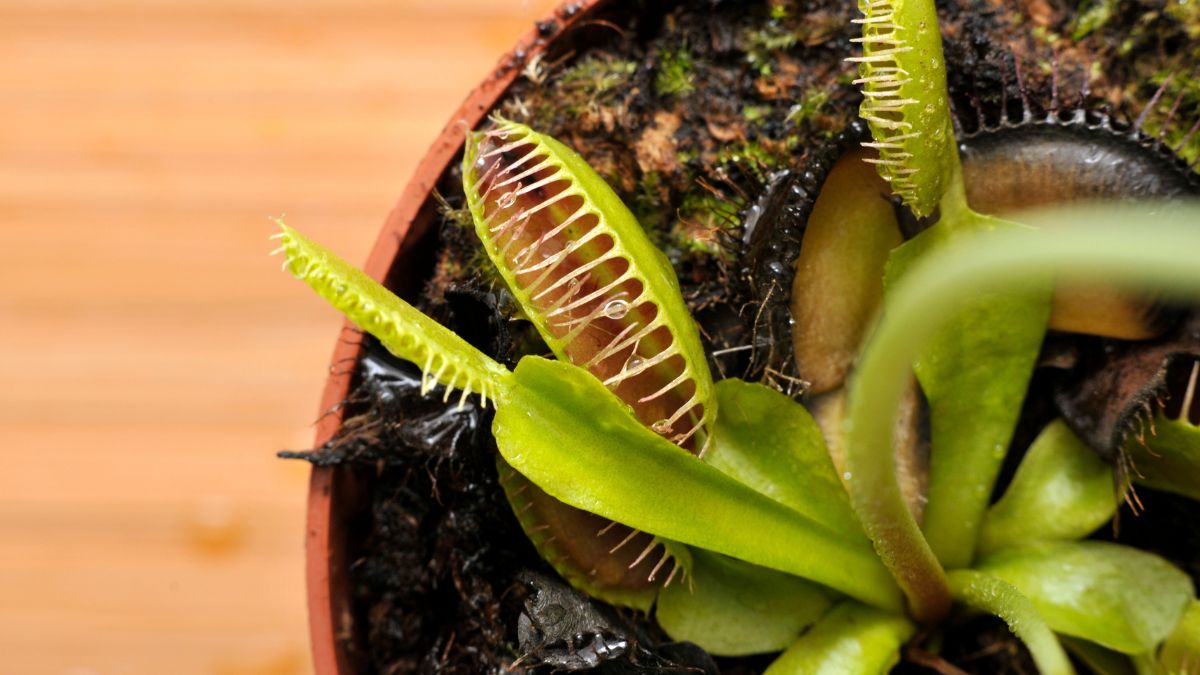If you want to Learn How to Make Carnivorous Plant Soil, then the information below will be of great benefit to you. The way that these plants capture and digest insects are quite fascinating. There are more than 700 different species available, many of which have incredible habitat adaptations.
These include rainbow plants, tropical pitcher plants, the cobra lily, the Venus flytrap, and American pitcher plants amongst others. There are several strategies used to grow these plants successfully. However, if you have a fair knowledge of the variety you’re growing, then maintaining their demands would be much easier.
You should also keep in mind that every species needs a unique mixture. This is because these plants cannot tolerate the standard garden soils or potting mixes. Using a growing medium with the highest quality is best. Go through the information below to learn more about the carnivorous plant soil mix and other useful tips.
Best Soil For Carnivorous Plants
To begin, it is important to remember that carnivorous plants should not be grown in garden soil! Knowing how to make carnivorous plant soil is essential if you want to have a flourishing garden. These requirements include individual ingredients and mixtures depending on the species you’re planting.
The majority of these grow healthily in a combination of high-quality peat moss, perlite, and sand. However, it is best to avoid using peat and perlite that has been fertilized as it is known to harm plants that consume other living things. Some varieties prefer a carnivorous plant soil mix that is more porous.
In this case, long-fiber sphagnum combined with horticultural charcoal, perlite, vermiculite, or other porous materials would be ideal. Many local nurseries and garden stores supply these products to plant growers. To keep the peat and perlite from leaking out of the bottom of the pots, line them with sphagnum moss that has long fibers.
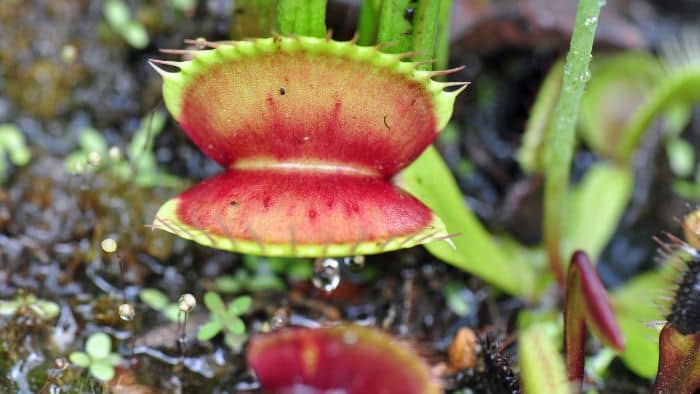
Follow This Soil Mix Recipe For The Best Results:
Mix together
– One part of debris-free sand that is lightweight.
– Three parts peat moss.
– Two parts live sphagnum moss
– One part long fibered and dried sphagnum moss.
Note: This is the preferred growing medium for the majority of carnivorous plants as it is rich in organic matter which helps them thrive.
For Indoor Carnivorous Plants, The Mixture Should Include:
– Two parts peat moss.
– One part lime-free horticultural sand
– One-part perlite
Note: This soil type is a low-fertility mix that is ideal for these plants. Alternatively, you could opt for a ready-to-use potting mix that is specially made for carnivorous plants.
Best Pots for Carnivorous Plants
You now have a clear idea of how to make carnivorous plant soil, so let’s discuss the best pots for growing them. This is because it is essential to choose the right type to ensure the health of your plant. As long as it can drain effectively and won’t become too hot when exposed to direct sunshine, you should be good to go.
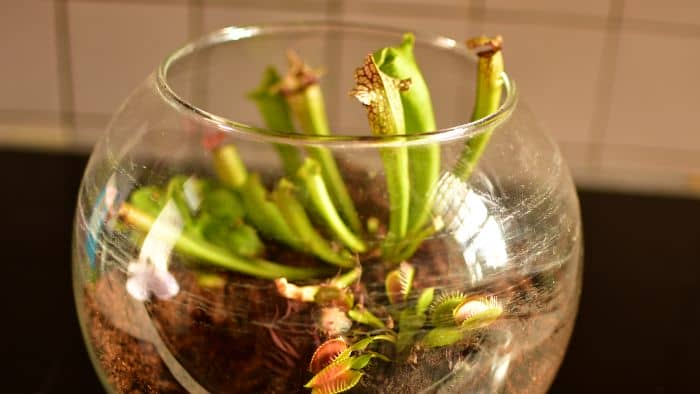
It’s important to take the size of the plants you intend to grow into account when selecting a container. If you use a very small pot, the soil won’t be able to keep adequate moisture, and there’s a high possibility that the root will become tangled. Particularly plants like the Venus Flytrap, whose roots require a longer, deeper pot need to have enough space to thrive.
However, it’s also crucial to avoid using extremely large planters. This is due to the fact that utilizing a large pot will cause your plants to focus their energy on developing their roots and won’t expand as a result. Pots come in a variety of sizes, materials, and shapes. These plants do well in plastic or glazed ceramic containers with holes at the bottom. Here are three of the best containers to grow them in.
Terracotta Pots
Terracotta looks fantastic anywhere you place them. It is made from iron-rich, permeable clay and is sought after because of its aeration abilities which keep the soil fresh. Additionally, it removes extra moisture from the roots of the plants by wicking it away. Their earthy tones, enhance the attractiveness of the carnivorous plants you place in them.
Plastic Planters
Plastic planters have improved greatly in terms of appearance and are a good option to grow these plants. They are reasonably priced, long-lasting, and have excellent moisture retention. They are also relatively lightweight which is great when moving them around to other spots.
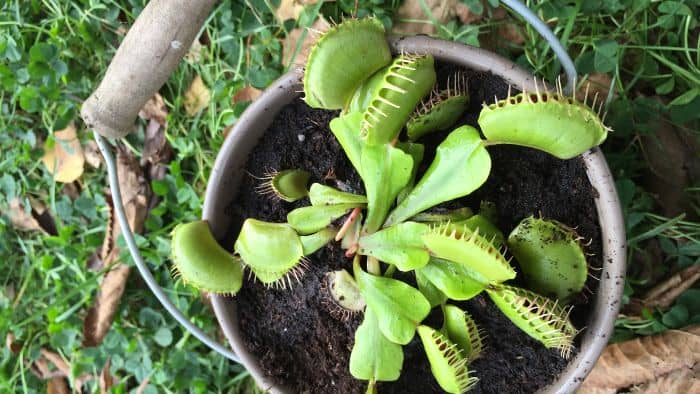
Cement Planters
The fact that concrete is heavy is a crucial point to keep in mind when using these plant pots. However, because it is sturdy, holds water, aids in insulation, and protects delicate root systems, it is particularly useful for growing carnivorous plants.
How To Care For Carnivorous Plants
Knowing how to make carnivorous plant soil is one of the best ways of caring for them. However, for these plants to reach their full potential, there are other maintenance requirements that should be implemented. This will aid them in growing healthily, affording you a thriving garden. Have a look at the important care tips below to know what these plants thrive on.
Tips:
1. Light requirements– Carnivorous plants thrive in direct sunshine and appreciate bright artificial light if grown indoors. This is why the smaller species of these plants can be grown indoors using fluorescent or other grow lamps.
2. Humidity requirements – Most carnivorous plants need high humidity levels to grow their best. This requirement can be easily met with an outdoor garden or an indoor terrarium in humid climates.
3. Water requirements – It is advisable not to use mineral or tap water on these plants. Rain or distilled water works best for bug-eating plants. The majority of carnivorous plants need moist soil throughout the hot summer months. Less moisture during the winter months is recommended to keep them healthy.
4. Soil requirements – A mixture of three parts peat moss to one part sand and perlite are the most popular media for most of these plant varieties. However, some of these plant species like Nepenthes prefer a mixture that is more porous.
5. Temperature requirements – The ideal temperature for carnivorous plants will depend heavily on the species you’re growing
6. Feeding requirements – An organic fertilizer will help plants while they are actively growing when insects are not present. Feeding them actual meat could be harmful because carnivorous plants cannot process complex proteins efficiently.
7. Pests and pesticides – Common pests that invade regular plants can also affect carnivorous plants. These include aphids, mealybugs, thrips, and scale. Fortunately, it is possible to cure all of these little plant parasites. Should this transpire, it is best to isolate the diseased plants before spraying them with organic pesticides. Rubbing alcohol can also be used to remove scale by wiping the plant leaves.
Have a look at this video to see how effective these plants are at trapping their prey.
Carnivores Plant Varieties and their Growing Habitats
Carnivorous plants have a variety of habitats in which they thrive. Most of these areas include swamps, waterbodies, woodlands, and sandy or rocky places that have a low nutrient availability. Insects and animals are captured and consumed by carnivorous plants for their nutrients. However, when growing these plants in pots or in your garden, it is vital to know how to make carnivorous plant soil to mimic their natural habitat.
Have a look at these important points to understand these plants better:
- The majority of meat-eating plants consume insects that are naturally attracted to them.
- Another important aspect of these plants is that the bigger varieties are able to consume small mammals and reptiles.
- Aquatic carnivorous plants consume crustaceans, mosquito larvae, and small fish.
- Because carnivory is a successful adaptation, it has evolved in several different plant groups.
- Carnivory doesn’t replace photosynthesis and root development systems. However, it’s recommended for providing nutritional value to plants. This is because it aids plants in utilizing all resources to their fullest potential.
- Every continent, with the exception of Antarctica, is home to carnivorous plants.
- Many of these species, such as sundews, butterworts, and bladderworts, are native to the UK.
- To hold its prey in place, this plant uses sticky sap on the surface of its leaf.
- In some varieties, their long stalks deter pollinators from the plant’s carnivorous leaves.
- The Attenborough pitcher plant species found in the Philippines is at risk of going extinct. It is amongst the largest carnivorous plants that devour rodents and grows to a height of 1.5 meters.
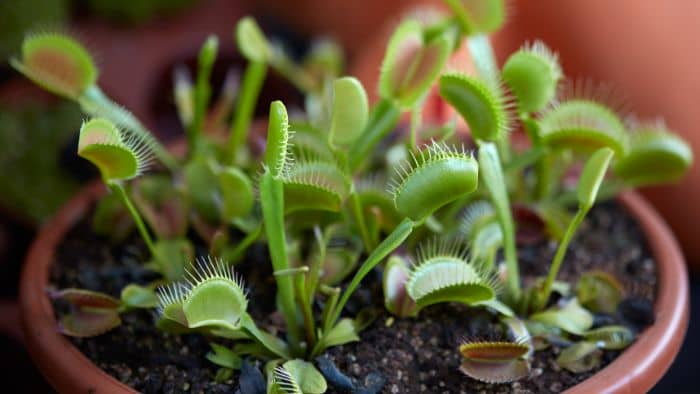
Conclusion
The choices of carnivorous plants available are plenty. Seeing that they grow throughout the world, choosing one that best suits the climate in your region would afford you a lush garden. However, keep in mind that when you are growing them at home, the care and maintenance tips listed above should be effectively implemented.
For this reason, we have given you a simple recipe on how to make carnivorous plant soil. This type of growing medium works effectively on most of these meat-eating plant varieties. Keep in mind that they can be grown in a variety of planters that are available at local garden centers.
Carnivorous plants can also naturally adapt to the environment they’re planted in as they are quite tolerant of certain conditions. Their efficiency in settling in enables them to thrive in some nutrient-deficient situations. This is because they are predatory plants that create an array of traps and sticky ploys to gain nutrients from animals and insects. Check out the International Carnivorous Plant Society for more details about these protein gobblers!

